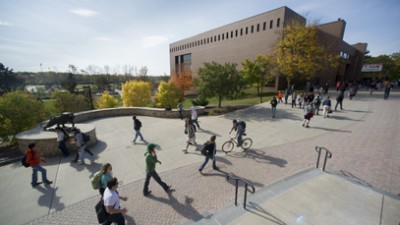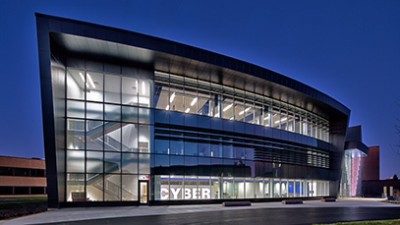Helping heart surgeons see more clearly
Elizabeth Lamark
Linwei Wang, associate professor of computing, is using artificial intelligence to advance non-invasive personalized health care for heart diseases.
Linwei Wang is blurring the lines of artificial intelligence and biomedicine research so that heart surgeons can see more clearly.
The associate professor in RIT’s computing and information sciences Ph.D. program is leading an international group of researchers and clinicians developing computational systems for creating individualized 3D imaging of a patient’s heart. With these 3D heart models, clinicians now have a noninvasive way to study their patients, helping improve patient care for cardiac arrhythmia and other heart diseases.
“Clinicians want to see how arrhythmia affects the heart physically, which unfortunately means using a catheter as opposed to just an EKG or MRI scan,” said Wang. “With our digital imaging, surgeons can spend hours studying a model of the patient’s heart, better preparing them before and after the procedure—all without negatively affecting the patient.”
At the center of Wang’s $3 million project, funded by the National Institutes of Health, is her research that uses artificial intelligence to discover new and better ways of understanding physics. Using the findings, Wang is integrating that data into her models to make imaging that is more accurate than ever.
“I’m interested in the bilateral connection between physics and data—in using data to improve physics-based modeling and learning physics from data,” said Wang. “Being able to apply what we learn to helping patients and addressing the challenges that clinicians face is motivating for me.”
In 2019, Wang’s work brought her to Washington, D.C., to receive the Presidential Early Career Award for Scientists and Engineers (PECASE). The PECASE is the highest honor bestowed by the U.S. government on outstanding scientists and engineers who are beginning their independent research careers and show exceptional promise for leadership in science and technology.
As director of RIT’s Computational Biomedicine Laboratory, Wang said that multidisciplinary collaboration is a signature part of her research and how she trains the nine Ph.D. students working in her lab.
Collaborating with experts in patient-specific cardiac modeling and high-performance computing, Wang and her team have been developing novel uncertainty quantification techniques that—leveraging advances in active machine learning—enable the propagation of uncertainty from the data used to model elements and develop future predictions.
Wang said this will help address the variability in personalized virtual organ models and help remove the major roadblock to widespread adoption of these models in decision support.
The team is also collaborating with clinicians to integrate physics knowledge into the development of machine learning methods, including learning to disentangle physiological factors of inter-subject variations from clinical data. Using this method, the team will develop a computer tool that can provide real-time automatic guidance during the ablation procedure.
“Dr. Wang is a pleasure to work with—we are collaborating to find new ways to understand and image the short circuits in the heart which can cause dangerous heart rhythms,” said Dr. John Sapp, professor of medicine at Dalhousie University in Nova Scotia, Canada. “If we can identify where the short circuits are, we may be able to find ways to fix them.”





